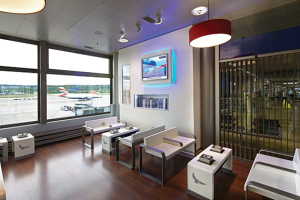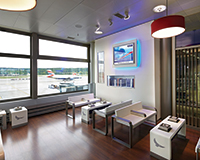 Despite numerous and ongoing public health campaigns encouraging us to quit, around one in five of UK adults smokes. The best estimates are that around 50m passengers who smoke are using UK airports each year, but relatively few are allowed to indulge in their habit airside (after security screening) as most UK airports don’t provide facilities for them.
Despite numerous and ongoing public health campaigns encouraging us to quit, around one in five of UK adults smokes. The best estimates are that around 50m passengers who smoke are using UK airports each year, but relatively few are allowed to indulge in their habit airside (after security screening) as most UK airports don’t provide facilities for them.
While there are exceptions, such as the Meriden Bar at Birmingham International, the rule for those who need a ciggie is either to break open the nicotine alternatives or to wait outside for as long as possible and then rush through security at the last minute, forgoing the pleasures of duty-free shopping, a drink in a bar or a restaurant meal.
Airport operators themselves are cagey about discussing the possibility of creating dedicated smoking areas, not least because of the public health ramifications. “We wouldn’t support that move at all. It would be a very retrograde step,” says Amanda Sandford, information manager at pro-health group ASH. Even airports such as Zürich that already run smoking lounges (see below) are careful not to suggest publicly that they do so explicitly for financial gain.
But if airports such as Zürich, Frankfurt, which has six smoking lounges, and Copenhagen, which has a two-level outside area, can manage it, why not, say, Heathrow or Gatwick?
“We can’t understand why the smoking ban shouldn’t be amended to give UK airports the option of installing comfortable smoking lounges similar to those in Frankfurt and other European airports,” says Simon Clark, director of pro-smoking group Forest.
Cost is one factor, suggests Charlotte Christiansen, associate director at Davis Coffer Lyons, who previously worked at Gatwick. But cost is not necessarily the main factor, as many lounges are sponsored by tobacco companies. “At an existing airport it can be tricky to create new space,” says Christiansen (see Dubai panel below). “You don’t want people roaming around on roadways or on the roof, where there is also often machinery.” Finding a suitable outside location where objects can’t be thrown on the aircraft taxiways or butts flicked near aircraft fuel can also be a challenge.
While smokers might appreciate the facilities, retail and leisure operators are not fighting for them, says Christiansen.
“It’s not an issue for us if people can’t smoke at our airport pubs,” says Eddie Gershon, spokesman for JD Wetherspoon.
Martin Morgan, director of Harper Dennis Hobbs, agrees. “In the case of airside catering units that have an outside area and include smokers, I’m not sure there is any evidence that this increases sales,” he says. “Indeed, non-smokers might be put off and might welcome some fresh air if they have been in the airport for a long time.”
For the moment, it seems, smokers at most UK airports will need to hold their breath once they pass through security.
Mainland Europe – Zürich
Zürich Airport (ZRH) has pioneered dedicated airside smoking areas in Europe. Last year, Switzerland’s busiest airport totted up a record 25.5m passengers. The airport entered a partnership with JTI (Japan Tobacco International) to operate dedicated lounges in 2004. When a nationwide smoking ban came into force in 2010, the airport worked to ensure that dedicated smoking space could still be provided.
There are now a total of 18 airside lounges that vary in size between approximately 400 sq ft and 1,000 sq ft, adding up to around 10,000 sq ft in total. The lounges promote JTI’s Winston and Camel brands. The airport declines to say how much it cost to create the areas, which have a total capacity of 600 people. Although no records are kept of how many people use the lounges, the airport suggests total occupancy is unlikely.
All of the smoking lounges are inside the terminal areas and there are no outside smoking areas airside. The airport says it hasn’t undertaken any research to understand passenger habits, so cannot measure to what extent the smoking areas extend airside dwell times or influence passenger choices in choosing to fly via ZRH.
Raffaela Stelzer, Zürich Airport’s corporate communications executive, says: “We believe that the smoking lounges enhance the comfort of our smoking passengers and therefore their overall satisfaction increases.” However, she says: “It is not a goal to boost retail sales by [having] smoking lounges.”
Middle East – Dubai
While many airports that are considering adding smoking accommodation would have to reconfigure existing space, Dubai Airports, operator of both airports in the UAE city, has the opportunity to start from scratch. Al Maktoum International (DWC), which opened in 2013, is planned to be the world’s largest airport in due course. A major expansion project to provide capacity for 26m people by 2017 started this autumn.
Simon Scott, head of international business at Leslie Jones Architecture, which advises DWC on its commercial strategy, says the perception of smoking indoors in Middle Eastern hub airports reflects the longer transit times and higher percentage of smokers. So, ventilated booths and lounges are already commonplace. “In Dubai there is an aspiration for the new airport to have better facilities, so that there will be an enhanced environment for smokers, and, indeed, all passengers,” he says.
A holistic approach to providing all-round better facilities is crucial in an area where passengers are likely to have a considerable choice over which airport to use – Abu Dhabi, Doha and Istanbul, for example, are all potential alternatives.
UK food and drink establishments and smoking
Eight years after smoking was outlawed from confined public spaces in the UK, how is the food and beverage trade across the country bearing up?
“I don’t think it hit operators as much as they thought it would,” says Tracey Mills, executive director at leisure specialist Davis Coffer Lyons. “When you’re devising a unit you factor in an outside area anyway to create a USP.”
Smokers are still able to vape (use electronic cigarettes), as legislation does not cover vaping, but many operators have placed a discretionary ban on the practice. “If you permit it, you alienate tobacco smokers and you turn your staff into policemen – so we simply don’t allow it,” says JD Wetherspoon spokesman Eddie Gershon.
While drinks-led businesses have undoubtedly suffered in recent years, other factors make it hard to single out the smoking ban as the only culprit, says James Davies, director of leisure agency at Fleurets. “The growth of fast casual dining and coffee shops has also contributed to the decline in these types of operators,” he adds.











